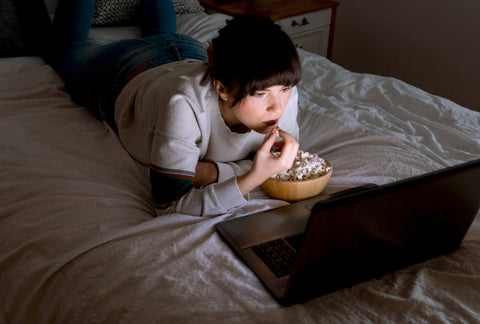When it comes to time spent reading or playing outdoors, children are growing up quite differently from the idyllic childhoods of yesteryear. By spending hours indoors and on screens, children are putting their wellbeing at risk, not to mention their connection to nature and to their fellow human beings.
We can all agree that childhood has changed but what’s less apparent is how screen time has made children’s eyesight and ultimately their physical and even mental health vulnerable. Unfortunate for already busy parents and grandparents, a proactive approach is needed to offset the long term damage caused by artificial sources of blue and green light from smartphones, immersive games, streaming television, and social media.
Let’s take a closer look at some reasons why we need to protect our children’s eyes.
- Blue Light Is Worse for the Eyes of Children
According to the American Optometric Association, “Children may be at higher risk for blue light retinal damage than adults. The juvenile lens absorbs less short-wavelength light than the adult lens, allowing more blue light to reach a child’s retina.” To put it simply small eyes, in particular, were not built for the intense exposure to blue light that results from prolonged screen time.
- Blue and Green Light Signals to the Brain to Stop Producing Melatonin
Melatonin helps your little one sleep and ultimately grow. How often have you struggled to fall asleep after watching too much TV or scrolling through your phone before bedtime? You’re not alone—it’s the blue and green light sending signals to your body that it’s day time, thereby keeping you awake. Poor athletic performance, hormonal changes, and increased risk of obesity are a few of the problems likely to spring up when a child isn’t able to get the sleep and daily exercise he or she needs.
- Green Light Also Negatively Influences the Circadian Rhythm (Your 24-hour Body Clock)
It is now more widely known that it’s not only blue light that’s a culprit in dysregulated circadian rhythms; exposure to green light at night (emitted by overhead lighting, smartphones, tablets, and computers) disturbs the natural wake and sleep cycle as well, leading to problems falling and staying asleep as well as daytime tiredness. Read more here about light's effect on our health and wellbeing.
- Too Much Artificial Light Leads to Sleepless Nights
Although the light emitted by personal electronic devices is not bright enough to damage the human retina, too much of it it can stimulate the blue-light-sensitive cell photoreceptors that regulate circadian rhythms. As a result, cellular telephone, tablet, and personal computer use before bedtime can delay sleep onset, degrade sleep quality, and impair alertness the following day.
- Blue Light Can Cause Long-Term Digital Eye Strain, Migraines and Sleep Disorders
When children spend long stretches of time exposed to artificial blue and green light, they may begin to suffer from digital eye strain. Symptoms of eye strain include sore or irritated eyes, fatigue, difficulty focusing, twitchy eyes and even severe headaches. Many trips to the optometrist turn out to be as a result of computer vision syndrome, the only cure for which is protective eyewear and reduced screen time.
- A Drop in Cognitive Performance
Children’s formative years have a long-term effect on their ability to learn and retain new concepts, problem-solve, and focus their attention. Getting restorative sleep is a vital part of a child’s development, and exposure to too many unnatural sources of blue and green light is a direct threat to their ability to sleep soundly and thrive.
Quick Fixes That Can Make A Big Difference.
We don’t have to sit by idly and watch the damage our children are unknowingly doing to their eyes. There are simple steps we can take and family rituals we can implement that will make a big impact on your child’s sleep and well being.
Insist that your children use blue light blocking glasses at least part of the time they are looking at screens. Also, check out the 7 best apps for preventing eye strain, blurred vision, and headaches.
Foster a culture where the TV and gadgets are switched off at a certain time, and a winding down process begins.
Nightlights provide a soft, gentle light in hallways and bathrooms so that you don’t need to turn on a strong, overhead light that wakes everyone up.
Red light has a far lower color temperature than blue or green light, and it doesn’t jolt the human body awake or alter your internal clock. Opting for red light bulbs in the evenings, especially in the bedroom, is one of the most proactive ways you can ensure your child gets a good night’s sleep.
We should take practical steps to protect our children’s eyesight as well as their ability to function well in the modern world. After all, children are going to benefit from proper sleep hygiene for years to come, and they can’t be held responsible for the damage caused by too much screen time.
SafetyBlue™, currently seeking FDA certification, is working to create protective glasses for children. Please get in touch with us to find out more.
SOURCES:
https://www.aoa.org/Documents/OptometryCares/Blue%20Light%20Impact%20in%20Children.pdf




